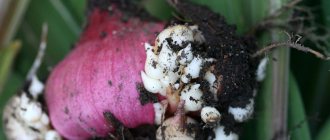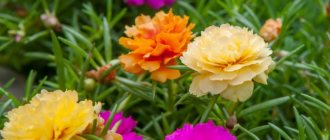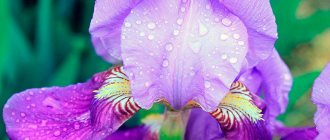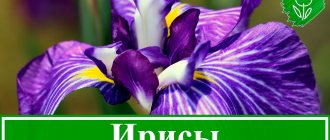Home » Flowers and plants » Indoor plants » Bulbous
Vladimir 03/17/2020
5791 Views
Irises
Irises are perennial herbaceous plants, numbering over 250 varieties. Under natural growing conditions, irises can be found in Asia, North America, Africa, and Europe.
Bulbous and rhizomatous plants delight the eye with a palette of colors. You can create a beautiful composition of irises, planting and caring for which is not difficult, by combining purple irises with blue, lilac with pink, yellow with light green and white.
Botanical description of irises: an excursion into history
Iris is an ornamental, perennial plant belonging to the Iris family. It is believed that the first flowers came to us from Asia. Under natural growing conditions, irises can be found in North America and Europe.
Beautiful iris flowers enchant with their airiness and tenderness
These are the most beautiful and common flowers. They decorate city parks and flower beds in summer cottages.
The plant has a long erect stem, elongated basal leaves, and huge flowers of different colors. In addition to decorative properties, irises also have medicinal properties. They are used to treat many diseases.
Irises - flowers of the goddess Iris
The iris got its name in honor of the ancient Greek goddess of the rainbow - Iris. And the name was given to it by Hippocrates. If you believe one legend, then at the time when Prometheus was distributing fire, a rainbow spread across the sky. One could admire such a beautiful event all day long, and the next morning, when the rainbow disappeared, flowers appeared that completely repeated the rainbow: they shone with all its colors.
In ancient times, iris was considered a powerful aphrodisiac. Men and women who consumed the powder believed that it caused a strong desire. The aroma of the flower was so strong and pleasant that it had an exciting effect on people and set them up for a loving pastime.
Variety of species
Planting and care
Botanists have divided the diversity of the natural world of irises into 2 types: rhizomatous and bulbous. Rhizomes, in turn, are divided into bearded and non-bearded or beardless. Each species has its own characteristics and growing conditions. Let's look at each type in more detail.
Bearded irises are the kings of the garden
The large group of charming irises includes tall, standard, low and dwarf plants.
Distinctive features of bearded irises:
- Coloring. You can find flowers ranging from snow-white to dark charcoal. Breeders have not developed only one variety of irises - there is no pure scarlet color.
- Texture. The petals have both a translucent and dense structure. You can find petals with a waxy texture
- Form . Thanks to breeding work, you can buy flowers of a classic shape, and if you want something original and unique, then you have the opportunity to have varieties with beautiful, foamy lace of openwork petals in your garden. Such flowers look like a soaring bird.
- Size. Among a wide range of low-growing and tall varieties, you can choose one that will be appropriate in landscape design and that will be attractive in appearance.
Beautiful varieties of bearded irises - worthy garden decoration
A wave of new varieties of bearded irises simply swept the country in the early 90s. Mass distribution played a cruel joke, turning against the flowers themselves. It was generally accepted that the newest varieties were inferior in quality to the older ones. However, this is an exaggerated opinion, so you should not give up beautiful varieties of irises for the sake of someone else’s opinion.
Among the huge variety you can find not only bearded irises, there are also Dutch and reticulated irises, which bloom in early spring from a planted bulb.
Dutch irises (xyphiums)
Elegant tall plants reaching a height of up to 50 cm. These are hybrid varieties bred by Dutch breeders. Planting material is represented by bulbs covered with scales in several layers. The color of the flowers can be snow-white, blue, yellow, blue, orange.
Representatives of the Dutch selection. Can be grown from bulbs. They bloom very early and delight with flowering for more than a month
You can find purple irises. Flowering begins in mid-May and continues until early June. By the end of August the foliage dries completely. Dutch irises are frost-resistant, but the bushes must be covered to avoid freezing.
They prefer sunny areas with fertile soil and neutral acidity. They look beautiful when cut and can be grown in flower beds and flower beds.
Reticulated irises (iridodictiums)
This group belongs to dwarf plants, not exceeding 10-15 cm in height. Such low-growing varieties are used to decorate borders, in flowerbeds, and look beautiful in flower beds.
Reticulate irises
However, low foliage is only before flowering. When the specimens fade, the foliage reaches a height of up to 50 cm. They bloom very early. Due to such early flowering, people also call them snowdrops.
Sisyrinchium californicum
A species with yellow flowers and slightly larger than Sisyurynchia angustifolia. Flowers open in May–June. In culture since 1796
Sisyurynchium Californian prefers a sunny location and sandy soils rich in humus. A more heat-loving species than the previous two, it needs winter shelter, or it can be grown as an annual crop, as well as in container planting.
Sisyurhynchium californica
Rosette blueeye, or rosette blueeye (Sisyrinchium rosulatum, Sisyrinchium brownei, Sisyrinchium exile)
Rare view. Even compared to the previous ones.
Sisyrinchium rosulatum
Sisyrinchium bellum, California blue-eyed grass (Sisyrinchium bellum)
Up to 60 cm high (possibly less) with purple-blue flowers. After flowering, the above-ground part of the plant dies off, and it remains dormant during the summer. Not found in the middle zone.
Sisyrinchium bellum
Varieties and varieties of irises
There is also a group of non-bearded irises, which includes all the remaining varieties of irises:
- Japanese and Siberian
- Louisiana and Spuria
- Californian
- swamp
They are all beautiful and deserve attention. The bearded plant includes the German iris.
German
Iris Germanica is considered the most beautiful variety of tall bearded iris. Among the beautiful varieties we can name several.
For example, the Acoma variety is famous for its sky-blue flowers. Along the edge of each petal there is a lavender border. Among Americans, the Acoma variety is considered the most popular.
Acoma
Baltic Sea is a vigorous plant with heavily ruffled flowers. The petals are colored blue, with a clearly visible blue beard.
Baltic Sea
Bewilderbest is an amazing variety with cream, ruffled, burgundy-reddish flowers. Each petal has white and yellow blotches and streaks.
Bewilderbest
Iris Germanis Ettension pliz is a perennial variety with beautiful flowers reaching 13-16 cm in diameter. The plant reaches a height of 70 cm.
Iris Attention Please
Germanic pink iris . The beauty of the pink bearded iris rivals that of a superb orchid. Pink inflorescences rise on a peduncle reaching a height of 15 cm. Characterized by early flowering. Prefers fertile, well-drained soil.
Iris germanica pink
Blue Magic. Simple, large flowers are located on tall peduncles, up to 30 cm high. The blue flowers of the decorative variety look great as cut flowers. If you plant the plant in spring, flowering will occur in the last ten days of June or early July.
Iris Blue Magic
Siberian
A large group that contains irises with natural colors ranging from blue to dark purple. During breeding work, over 1000 varieties of Siberian iris were bred, differing in color.
Snow Queen is a variety with dazzling snow-white flowers.
Iris sibirica 'Snow Queen'
Batts and Sugar - the flowers are yellow, with a white border along the edge.
Batts and Suga
Imperial Opal is a tall variety with lavender flowers reaching 10 cm in diameter.
Imperial Opal
When purchasing Siberian irises, it is important to know one feature of this variety: the flowers are fragrant!
Japanese
Other names have also been assigned to this variety - xiphoid iris and Kaempfler's iris. The flowers of the representatives of the group are similar to orchids; they reach 25 cm in diameter, just like Siberian irises, they are devoid of aroma.
Thanks to the breeding work of Japanese specialists, a garden form of the Japanese iris was developed, which was given the name hana-shobu. However, this species has poor resistance to low temperatures, so it is not recommended for cultivation in our conditions.
Nessa-No-Mai. The variety is characterized by good growth and resistance to climatic conditions. The petals of the flowers are purple, with white spots clearly visible. The flowers are very huge - up to 25 cm in diameter.
Nessa No Mai
Vasily Alferov . The variety is for everyone. The fact is that the flowers are simple, not double, and they are painted inky.
Vasily Alferov
Solveig . Delicate iris flowers are light lilac in color.
Solveig
Angel Mountain. Exotic plant with white and purple flowers.
Angel Mountain
Iris spuria
A very elegant flower. In appearance it has some similarities with xyphium, only the flowers are much larger.
Of the characteristics, two most important ones can be distinguished: the variety is resistant to drought and low temperatures, that is, it winters well in regions with severe frosts.
Lemon Touch. The height of the plant under good conditions can reach 1 m. The flowers are yellow-lemon, the edges of the petals are strongly corrugated, and there is also a golden stripe along the edge.
Lemon Touch
Stella Irene. The throat is golden in color, the petals themselves are purple-black. It can reach a height of 90 cm.
Stella Irene iris
Bolotny
People also call it false calamus iris. A very interesting species, sensitive to growing conditions. The name itself suggests that the marsh iris prefers wetlands, and will not grow in conditions with a lack of moisture.
In nature you can find yellow irises. Landscape designers use this type to frame the banks of reservoirs.
Flore Pleno is a variety with double flowers.
Flore Pleno
Golden Queen or "shaggy bee" has yellow flowers.
Golden Queen
Iris reticulum Harmony
An early bulbous plant. The bulb reaches 1.5-2 cm in diameter and is elongated-ovoid in shape. The bulb is covered with fleshy scales covered with a dry mesh.
The foliage is narrow, cylindrical. During flowering, the iris produces a peduncle 15-20 cm high.
Harmony irises are colored reddish-purple or light blue with flower sizes up to 5-8 cm. Used to decorate garden plots.
You need to plant according to the planting pattern: 10x8 cm, where 10 cm is the distance between rows, and 8 cm is between the bulbs.
Iris reticulum Harmony
Varieties of irises differ in the color of their flowers and are also divided into certain groups:
- two-tone - the upper and lower petals are painted in different shades of the same tone;
- plain - all parts of the colors have the same shade;
- variegata - the upper petals are yellow, the lower petals are red-brown;
- two-color - the upper and lower petals differ in color, and can be combined as a contrasting color, so they can differ in shade in the same tone;
- amena – upper petals – snow-white;
- iridescent - on the petals there is a smooth transition from one color to another;
- bordered - the petals have a beautiful corrugated ruffle of a different tone.
Among the huge variety, you can choose exactly those varieties that suit your taste and technical characteristics for growing in a given area.
H
Features of planting Dutch, reticulated and bearded irises
Many gardeners do not want to plant irises on their property, citing the fact that caring for flowers requires having some specific knowledge.
But growing irises is not a labor-intensive task; you just need to know the varieties of iris you purchased and how to care for the particular variety you bought in the store.
Unpretentious plants serve as a worthy decoration for a suburban area
Features of growing bearded irises
1The first feature is that some rhizomes grow horizontally and may become bare over time. Therefore, it is recommended to cover the plantings with mulch for the winter to prevent the roots from freezing .
2 Irises do not tolerate excess organic fertilizers . If you want to pamper your plants, it is better to apply mineral fertilizers dissolved in water for planting.
3 When planting, it is advisable to pour sand into the bottom of the hole . If you bury the rhizome, the flowers will stop blooming.
4During the growing season, irises have the ability to move to a certain distance other than the planting site. To make the rows look even, you will need to plant irises in a fan along the row, not across.
By following simple rules, you can create a beautiful and compact flower garden that will decorate your summer cottage.
Contrary to the generally accepted belief that irises need to be divided immediately after flowering, it can be said that irises can be replanted at any time of the year: early spring, summer and even autumn. If the weather in the region is warm, then there is no need to rush to transfer.
It is recommended to replant bearded irises once every 3 years in order not only to propagate the variety, but also to prevent it from dying. Siberian irises are replanted less frequently, once every 10 years. It can be done more often, the main thing is to prevent the variety from degenerating.
Planting bearded irises
Bearded irises prefer areas with good light. They do not like drafts, so for planting it is recommended to choose a sunny place, protected from the winds. In the spring, when the snow melts, moisture should not linger in the area with irises.
Before planting, you need to dig a hole that will correspond to the size of the iris root system. It is recommended to pour fine river sand into the bottom of the hole. Then, you need to place the rhizome on the resulting mound of sand, straighten the roots and sprinkle them with soil.
A mixture of bright colors of bearded irises stands out as a bright spot on the site
When planting, you need to make sure that the upper part of the rhizome is not deeply buried in the soil . It is better to do so so that part of the rhizome protrudes slightly above the surface and is accessible to the rays of the sun.
Planted plants do not need watering. If the division of the iris and its subsequent planting were carried out in the previous year, it is recommended to remove the flower shoot so as not to deplete the plant’s strength.
If you really want to admire the flowers of a new variety, it is recommended to cut off the peduncle with buds. They will bloom already in the vase, and using this method, you will not deplete the plant.
Features of planting Dutch irises
In stores you can find bulbs and rhizomes of Dutch irises. Rhizomatous irises are planted in August or early September. The site should have loose, breathable soil, soil with low acidity.
Before planting, it should be taken into account that irises should not subsequently be obscured by other tall plants, otherwise such proximity will negatively affect flowering.
Delicate Dutch irises grown from bulbs
For planting, dig a hole that is 2 times larger than the size of the rhizome itself. After the rhizome is covered with soil, you need to add another layer of mulch. This will prevent the soil from freezing in winter, and in summer it will protect the root system from overheating. You can mulch with hay, straw, and tree bark.
Planting bulbs
Iris bulbs
There are some discrepancies in planting rhizomes and bulbs, which are important to take into account when planting the prepared material:
1Before planting, iris bulbs must be placed in a fungicide solution for disinfection. This procedure will prevent the possibility of rotting of the bulb. After removal from the solution, the planting material must be dried.
2The planting site must be spilled with a weak solution of potassium permanganate to kill pathogenic microorganisms.
3The bulbs should be planted according to a 15x15 cm pattern. With this planting, the specimens will not shade each other.
4At the end, the bulbs are sprinkled with soil and watered.
Dutch irises bloom in mid to late May, but there is a discrepancy: some bloom in early June. The buds quickly wither, especially on hot days.
Caring for Dutch flowers after flowering
After flowering, it is recommended to wait for the foliage to dry, then dig up the bulbs and dry for 2 weeks in a well-ventilated area.
Irises bloom
Some gardeners recommend drying outdoors , but you need to make sure that the scorching rays do not dry out the bulbs. Store in canvas bags in a ventilated place.
IRISES NEED GOOD CARE AFTER PLANTING IN OPEN GROUND
All irises (except Japanese) are quite drought-resistant. They accumulate moisture in the roots and therefore can do without it for a long time. But the soil around them should always be moist and loose. During the flowering period, water more often. It is recommended to water in the evening, making sure that drops of water do not fall on the flowers and leaves.
Irises are fed three times per season: in the spring, the plants are given nitrogen nutrition (urea solution or infusion of cow dung in a ratio of 1:10). In summer they give nitrogen-potassium fertilizers, and in autumn - potassium-phosphorus fertilizers.
After flowering ends, all dried leaves and flowers are carefully trimmed. Bearded miniature and medium-sized ones, as well as Siberian irises, do not cover for the winter. The rest are mulched with dry leaves and covered with spruce branches.
General rules for caring for plants
Caring for irises does not involve difficulties; it is important to know what the plant likes and follow its whims
Soil selection and preparation
- Irises prefer fertile soil with neutral acidity. Can be planted on loams.
- Flowers can be grown in the same place for no more than 3-5 years, then it is recommended to transfer the planting to a new permanent residence.
Watering
- When planting, the rhizomes are located close to the soil surface, so excessive soil moisture can cause root rot.
- Over-watering contributes to the appearance of black, unsightly dots on the foliage, which subsequently also rot. Therefore, in the first half of summer, the plant is watered abundantly, and starting from the second half, watering is reduced.
- Elegant and beautiful irises can be grown by March 8th.
- Women will be delighted with such a gift. For forcing you need to take bulbous irises.
Illumination
- Good growth of irises and abundant flowering largely depends on the choice of location. The area should be well lit.
- When shaded, the irises will not have enough light, so the brightness of the flowers will be lost and flowering will be more sparse.
- Flowers are badly affected by gusts of wind and drafts. Therefore, when choosing a site, you need to take this feature into account.
Temperature
- Almost all types of irises tolerate even the most severe frosts well, so when preparing for winter you will only have to lightly mulch the ground.
- Beautifully decorated flower beds with irises attract the attention of passers-by. I just want to stop and inhale the aroma of charming “butterflies”.
Fertilizer application
- Irises need additional nutrients, especially when grown in one place for a long time. The first feeding is carried out in early spring. At this time, mineral fertilizers are scattered between plantings.
- During budding, it is recommended to apply potassium fertilizers. In August they are fed with phosphorus and potassium supplements. This procedure improves immunity and helps plants survive the winter.
Transfer to a new place
- When grown in the same place for a long time, you can notice such a feature that the irises stop blooming. This means they need to be transplanted into new nutrient soil.
- Plants are replanted after they have flowered. During this time, the irises have time to take root in a new place. Transplanted irises begin to bloom in the 2nd year.
- Before planting, mineral fertilizers are applied to the soil. Gardeners do not recommend adding organic compounds to the soil.
Propagation of irises
There are several ways to propagate irises: seed and vegetative.
Seed propagation is used mainly by breeders to obtain a new variety. This method is used quite rarely by summer residents, as it has certain difficulties.
Preparing the bush before dividing the rhizome
When forcing irises, it is important to use additional lighting. If it becomes clear that you are not meeting the deadlines, then you can extend the time for additional illumination of the plants. And then you can definitely get the treasured bouquet of irises for a certain holiday.
Vegetative propagation is carried out by dividing the rhizome into parts. With this method, flowering occurs the next year.
By dividing the rhizomes, wild and varietal irises can be propagated.
Rules for dividing rhizomes
1For propagation, you need to choose a healthy mother plant, without visible damage by pests and diseases.
2After removal from the ground, it is necessary to shake off the sand from the roots and divide the rhizomes into parts so that each of them contains one leaf bud or bunch. The delenka must have its own root system.
3For better rooting, the foliage will have to be cut by half, and the roots by 1/3.
4When dividing, inspect the rhizomes and remove damaged leaves and roots.
5Next, you need to disinfect the cuttings by immersing them in a weak solution of potassium permanganate for 15 minutes.
6The cut area should be sprinkled with coal.
Before planting, river sand is poured into the hole, part of the rhizome is placed on it and sprinkled with soil. When planting, it is important to maintain a distance of 0.5 meters between specimens.
How to plant varietal irises correctly
The quality result depends on the correct landing. Irises are not the most fastidious plants, so for this you will need general information. Irises are perennial flowers, so they are planted once every 2-3 years. Irises can be planted in spring, autumn or summer after flowering.
For planting, choose well-lit places protected from the wind. You also need to provide high-quality watering, but not overdo it.
Irises need soil rich in nutrients. If there are not enough of them, rotted compost and manure are added before planting. Acidic soil is neutralized with wood ash, chalk, dolomite flour or lime. Loamy soils are supplemented with peat and sand, and sandy soils are supplemented with clay soils. To prevent weeds from disturbing the plants, treat the soil with herbicides before planting, and use fungicides against diseases.
Plant irises in holes, carefully placing the roots. For bearded irises, the upper part should remain above the ground; for bearded irises, it can be covered with soil a couple of centimeters. Taking into account the fact that irises grow quickly, 0.5 m is left between the bushes. You can read about planting rules in the article Properly replanting irises.
In the spring, irises are planted after the snow melts, when the soil warms up to +10 degrees and frosts have passed.
Another planting time is late summer or early autumn, when flowering ends.
Using a pitchfork, the tubers are separated into annual links with leaves and replanted. Be sure to inspect them, remove rotten areas, and disinfect them in a solution of potassium permanganate.
Pests and diseases of irises
Irises are unpretentious plants that feel great even with minimal care.
However, sometimes plants can get sick or be attacked by pests. To prevent the colonial spread of insects, you will need to inspect the plantings more often for diseases or harmful insects.
Leaf base rot and root rot When growing irises in waterlogged soil, a scourge such as rot occurs. To fix the problem, the plant will need to be removed from the ground, cleared of soil and all diseased areas removed, cutting with a knife to healthy tissue.
Next, you will need to dip the remaining rhizome in a growth stimulator solution. After the plant has dried a little in the sun during the day, it can be planted on the site.
Gladiolus thrips Signs that gladiolus thrips has settled on the plant can be recognized by the foliage - it becomes lethargic and loses its glossy shine. The fight needs to be carried out only with the help of special chemicals; folk remedies do not give a positive result.
Heterosporosis When examining the foliage of a diseased plant, you may notice small brown spots. As a preventive measure, it is necessary to cut off the entire above-ground part and burn it away from the site. After this, the irises need to be treated with a solution of copper sulfate.
Growing irises: when to plant flowers and what to consider
It is not so easy to find a gardener who would not plant at least a couple of iris bulbs in his flower garden. These unpretentious plants do not require any special care at all, and that is why they are so loved by land owners. Each of them knows that it is very important to plant the crop correctly and provide proper primary care.
Iris in Greek means Rainbow.
In a garden of continuous flowering, irises successfully fill the gap between early spring and summer flowers. In the conditions of the Moscow region, they begin to bloom in the second ten days of May, when late varieties of tulips are still showing off, and finish flowering in the first ten days of July, when lilies and roses bloom. With skillful selection of varieties, irises can bloom for up to two months.
Irises in landscape design
To decorate a rock garden, you can choose beautiful varieties of dwarf irises
In a rocky garden, this type of irises will look beautiful against the background of saxifrage, sedums and awl-shaped phlox. Dwarf irises stand out favorably over low grasses, crowded bells, and creeping low-growing shrubs.
Bearded and Siberian irises harmonize well with marsh irises. The foreground of this composition can be created from an initial letter and garden geranium.
Irises can be used to decorate ridges : it is recommended to plant flowers on both sides of the garden paths.
To grow a lot of varietal irises on your site, you will need to find a good supplier of planting material to be sure that neither work nor money will be wasted.
If you want to create a rock garden, then irises should be combined with conifers. A small Christmas tree or decorative pine must grow.
It is preferable to plant marsh irises in the coastal zone of an artificial reservoir











